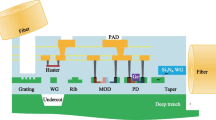Abstract
To address the driving power and density of wavelength-division-multiplexing (WDM) computing architectures, a Fano resonator based on a photonic crystal nanobeam is proposed. The Fano resonator comprises a T-shaped waveguide, introducing an additional phase shift in the continuous propagation mode, and a photonic crystal nanobeam with a discrete mode. The device has one resonance peak within wavelength ranging from 1 500 nm to 1 600 nm, with a maximum extinction ratio of 8.7 dB and a transmission spectrum slope of up to 11.30 dB/nm. The device has good reusability, extinction ratio, and spectral resolution. It is expected to provide essential photonic components for low-energy consumption and high-density photonic computing to meet the requirements of future convolutional neural network (CNN) acceleration computing.
Similar content being viewed by others
References
HUANG Y, HUANG B, CHENG C, et al. Feature extraction from images using integrated photonic convolutional kernel[J]. IEEE photonics journal, 2022, 14(3): 1–7.
ANGARI V, MARQUEZ B A, MILLER H, et al. Digital electronics and analog photonics for convolutional neural networks (DEAP-CNNs)[J]. IEEE journal of selected topics in quantum electronics, 2019, 26(1): 1–13.
MILLER D A B. Attojoule optoelectronics for low-energy information processing and communications[J]. Journal of lightwave technology, 2017, 35(3): 346–396.
KRIZHEVSKY A, SUTSKEVER I, HINTON G. ImageNet classification with deep convolutional neural networks[J]. Advances in neural information processing systems, 2012, 25(2).
PRUCNAL P R, BHAVIN J S. Neuromorphic photonics[M]. Boca Raton: CRC press, 2017.
ISHIO H, MINOWA J, NOSU K. Review and status of wavelength-division-multiplexing technology and its application[J]. Journal of lightwave technology, 1984, 2(4): 448–463.
DING X, WU G, ZUO F, et al. Bidirectional optical amplifier for time transfer using bidirectional WDM transmission[J]. Optoelectronics letters, 2019, 15(6): 401–405.
HINAKURA Y, AKIYAMA D, ITO H, et al. Silicon photonic crystal modulators for high-speed transmission and wavelength division multiplexing[J]. IEEE journal of selected topics in quantum electronics, 2020, 27(3): 1–8.
DONG P. Silicon photonic integrated circuits for wavelength-division multiplexing applications[J]. IEEE journal of selected topics in quantum electronics, 2016, 22(6): 370–378.
LIU W, LIU W, YE Y, et al. Holylight: a nanophotonic accelerator for deep learning in data centers[C]//2019 Design, Automation & Test in Europe Conference & Exhibition (DATE), March 25–29, 2019, Florence, Italy. New York: IEEE, 2019: 1483–1488.
JHA A, HUANG C, DELIMA T F, et al. Nanophotonic cavity based synapse for scalable photonic neural networks[J]. IEEE journal of selected topics in quantum electronics, 2022, 28(6): 1–8.
GU L, WANG B, YUAN Q, et al. Fano resonance from a one-dimensional topological photonic crystal[J]. APL photonics, 2021, 6(8): 086105.
MENG Z M, LIANG A, LI Z Y. Fano resonances in photonic crystal nanobeams side-coupled with nanobeam cavities[J]. Journal of applied physics, 2017, 121(19): 193102.
XU W, ZHU Z H, LIU K, et al. Chip-integrated nearly perfect absorber at telecom wavelengths by graphene coupled with nanobeam cavity[J]. Optics letters, 2015, 40(14): 3256–3259.
YU H, QIU F. Compact thermo-optic modulator based on a titanium dioxide micro-ring resonator[J]. Optics letters, 2022, 47(8): 2093–2096.
XU Y, LU L, CHEN G, et al. T-shaped silicon waveguide coupled with a micro-ring resonator-based Fano resonance modulator[J]. Applied optics, 2022, 61(31): 9217–9224.
Author information
Authors and Affiliations
Corresponding author
Ethics declarations
Conflicts of interest
The authors declare no conflict of interest.
Additional information
This work has been supported by the Science and Technology Project of the State Grid Zhejiang Electric Power Company Limited (No.B311XT21004G).
Rights and permissions
About this article
Cite this article
Wang, Y., Lu, W., Lai, X. et al. Silicon-based Fano resonance devices based on photonic crystal nanobeams. Optoelectron. Lett. 19, 727–731 (2023). https://doi.org/10.1007/s11801-023-3067-0
Received:
Revised:
Published:
Issue Date:
DOI: https://doi.org/10.1007/s11801-023-3067-0




